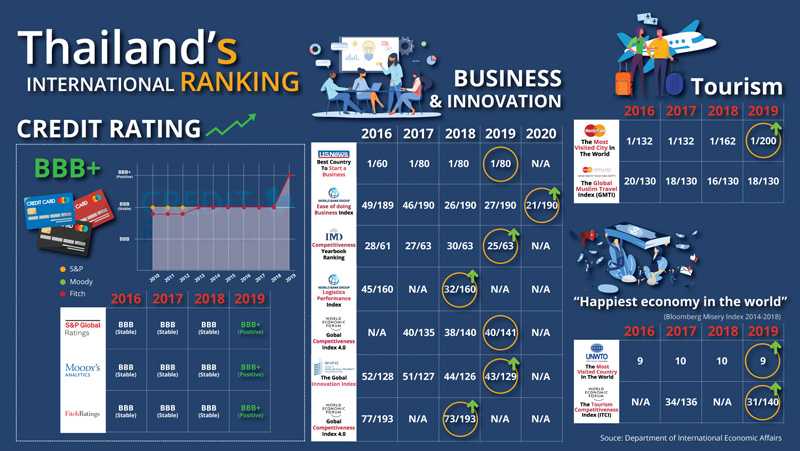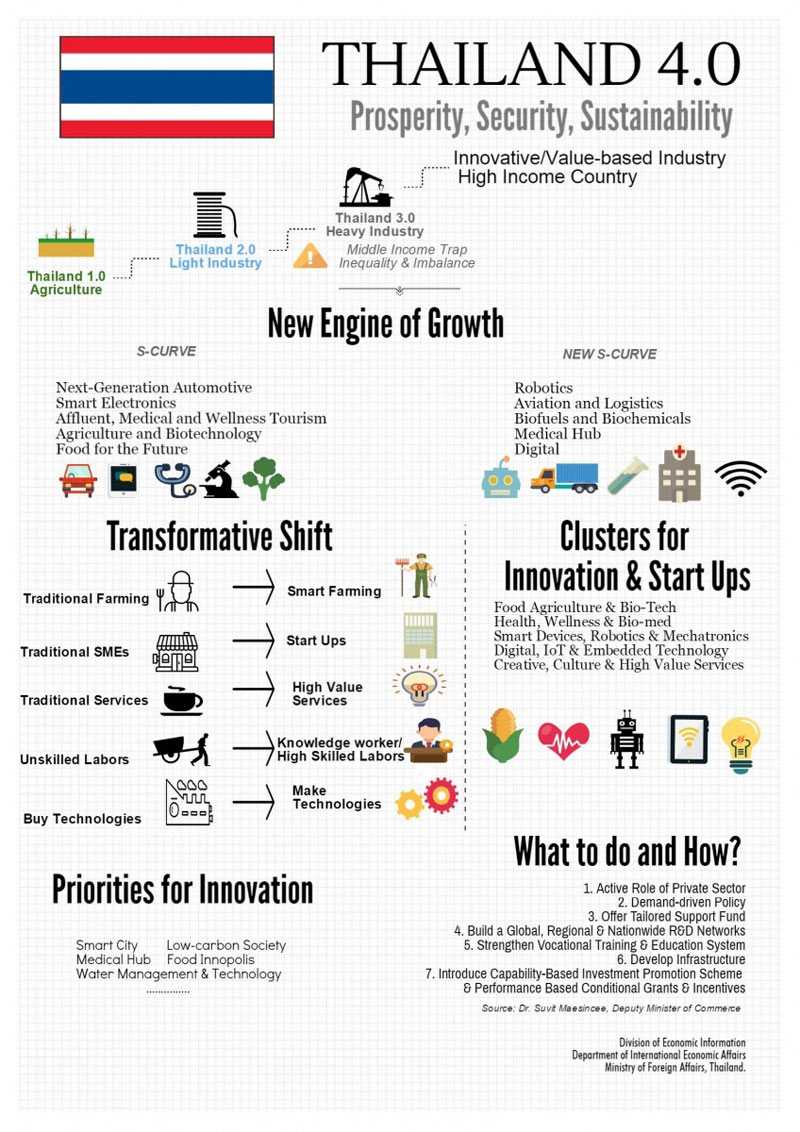Saturday Apr 27, 2024
Saturday Apr 27, 2024
Saturday, 5 December 2020 10:24 - - {{hitsCtrl.values.hits}}

As the second largest economy in Southeast Asia and the world’s 19th largest manufacturer, the Kingdom of Thailand has consistently achieved robust economic growth thanks to the country’s strong fundamentals and diverse industries. These same factors are also sources of resilience that allowed the country to recover quickly from the 2008 global financial crisis.


The Thai economy registered 1.6% growth in the fourth quarter of 2019. The overall economic expansion for the Thai economy in 2019 was projected in the range of 1.5 - 2.5%. Thailand’s exports also declined by 2.7% in the same period.
Looking to the future, Thailand’s economic development is set to follow a 20-year National Strategy Plan, with a vision of achieving security, prosperity and sustainability. The 12th National Economic and Social Development Plan (2017 - 2021) was thus mapped out in line with the National Strategy Plan. The principles of the “Sufficiency Economy Philosophy” continue to be a vital element of the 12th Plan, as they have significantly contributed to balanced and sustainable development in Thailand over many years.
Thailand 4.0
The country's path forward will follow an economic model called Thailand 4.0, which aims to unlock Thailand from several economic challenges and help the country break free from the middle-income trap. The economic model focusses on four objectives: economic prosperity, social well-being, raising human values, and environmental protection.
To achieve economic prosperity, the key drivers will be innovation, technology and creativity. The Thai government aims to raise research and development expenditure to 1.5% of the GDP, increase economic growth to annual rates of no less than 5% within five years, and boost national income per capita from US$5,470 in 2014 to US$15,000 by 2032.
To promote social well-being, the Thailand 4.0 model focusses on encouraging all members of society to reach their full potential, and reducing social disparity and income inequality. The economic model also aims to develop human capital by transforming cost-effective labour into a skilled workforce.
For environmental protection, Thailand will ensure that natural assets can produce their full economic potential on a sustainable basis. This includes the provision of clean air and water, and the resilient biodiversity needed to support food production and human health.
In applying the Thailand 4.0 Model, the Thai government has launched the SMART Visa. Designed to encourage highly skilled professionals to work or invest in the Kingdom. SMART Visas provide more benefits and privileges than any other type of visa issued by Thailand. This eliminates the need for a work permit, and also extends to spouses and children of those who qualify. SMART Visas are available for investors, executives, talented individuals, and those involved in start-
up incubators and accelerators that are working in one of the 11 industries targetted by the Thai government.
Eastern Economic Corridor (EEC)
To entice more technology-driven investment into the country, the Eastern Economic Corridor (EEC) was established as a prime location for the world’s top companies wishing to expand their investments in the Southeast Asian region. The new economic zone, which covers Rayong, Chon Buri, and Chachoengsao provinces, will receive heavy investment in infrastructure development both for improving the existing infrastructure and building new networks.
Conforming to the Thailand 4.0 Model, the new economic zone is envisioned as a modern metropolitan area, a competitive place for trade and investment, a base for regional transportation and logistics, a hub for human resources, a tourist attraction, and most importantly, a modernised gateway to Asia.
The ambitious sea transportation development plan for the economic zone includes expanding existing deep-sea ports. The Laem Chabang Port is expected to rank among the world’s top 15 cargo ports and will serve as the Gateway to Southeast Asia. The Map Ta Phut Industrial Port will greatly expand its capacities to accommodate a higher volume of liquefied natural gas, from the existing 10 million tonnes to 62 million tonnes per year. Sattahip Commercial Port, Thailand’s third deep-sea port, will be upgraded and modernised to become an international cruise and ferry port, meeting global standards and accommodating the region’s growing shipbuilding and off-shore oil rig assembly industries.
Air transportation will also undergo similar intensive improvements. U-Tapao -Rayong - Pattaya International Airport, a cornerstone of the EEC, will be developed extensively with the aim to eventually reach a capacity of 60 million passengers per year. The Airport will serve as major transportation and logistics hub and will be linked with the Suvarnabhumi and Don Mueang International Airports via high-speed trains, dual-track railways, and an expressway.
In parallel with the infrastructure development, the three provinces of Chachoengsao, Chon Buri and Rayong will be equipped with leisure and lifestyle facilities that rival any modern metropolis. Based on the philosophy of sustainable urbanisation, inhabitants in the economic zone will live in an environment that encourages a work-life balance with thriving tourism and wellness industries.
As infrastructure development in the EEC is underway, investment incentives will play an integral role in enticing foreign investment in the economic zone. Under the Eastern Economic Corridor Act B.E. 2561 (2018), companies operating in the economic zone will have their taxes halved for an additional period of five years. In addition, the National Competitive Enhancement Act for Targeted Industries B.E. 2560 (2017) provides a corporate income tax exemption for up to 15 years for eligible businesses in industries that are expected to contribute to Thailand’s development.
Driving Economic Growth through Innovation
Thailand 4.0’s New Engines of Growth initiative consists of two groups. The first is the upgrading of five existing industries: agriculture and food, tourism, automotive, electrical and electronics industries, and petrochemicals. The second one involves the development of six new sectors: automation and robotics, aerospace, digital, bioenergy and biochemicals, medical and healthcare, and the defense industry.
The model will be carried out by using science, technology, innovation and creativity to transform Thailand’s rich biodiversity and cultural diversity from a comparative advantage to a competitive advantage. Thus, the government is concentrating on developing technologies that will become an essential base for the development of other high-value industries that will drive Thailand towards a prosperous future.
Going Digital
Thailand is stepping up to a new challenge of digital economy. The Thai government has laid out several initiatives to develop the digital economy by supporting the production of hardware, software, communication devices, and digital platforms for the industrial sector and financial services. In particular, the government will target investments in high-speed Internet access to support future industries, innovation, and e-commerce.
The Smart Cities initiative will initially see the transformation of Phuket, Chiang Mai, and Khon Kaen provinces, as integrated digital technology, energy and transport hubs, which will bring about a positive socio-economic impact for residents. Other cities in Thailand will eventually be included in the initiative in the future.
Another project called Digital Park Thailand will support technology transfer and the creation of digital innovations; such as, mobile applications, data centres, and the ‘Internet of Things’ products. Located on a 250-acre plot of land in Chon Buri province, Digital Park Thailand will become a vibrant digital innovation hub and a competitive digital community, as well as a destination for global digital players and innovators to invest, work, learn and play. The project will also see Thailand become a data hub for the ASEAN Economic Community AEC) offering ultra-high-speed broadband infrastructure, international submarine cable stations, data centres, and satellite earth stations.

